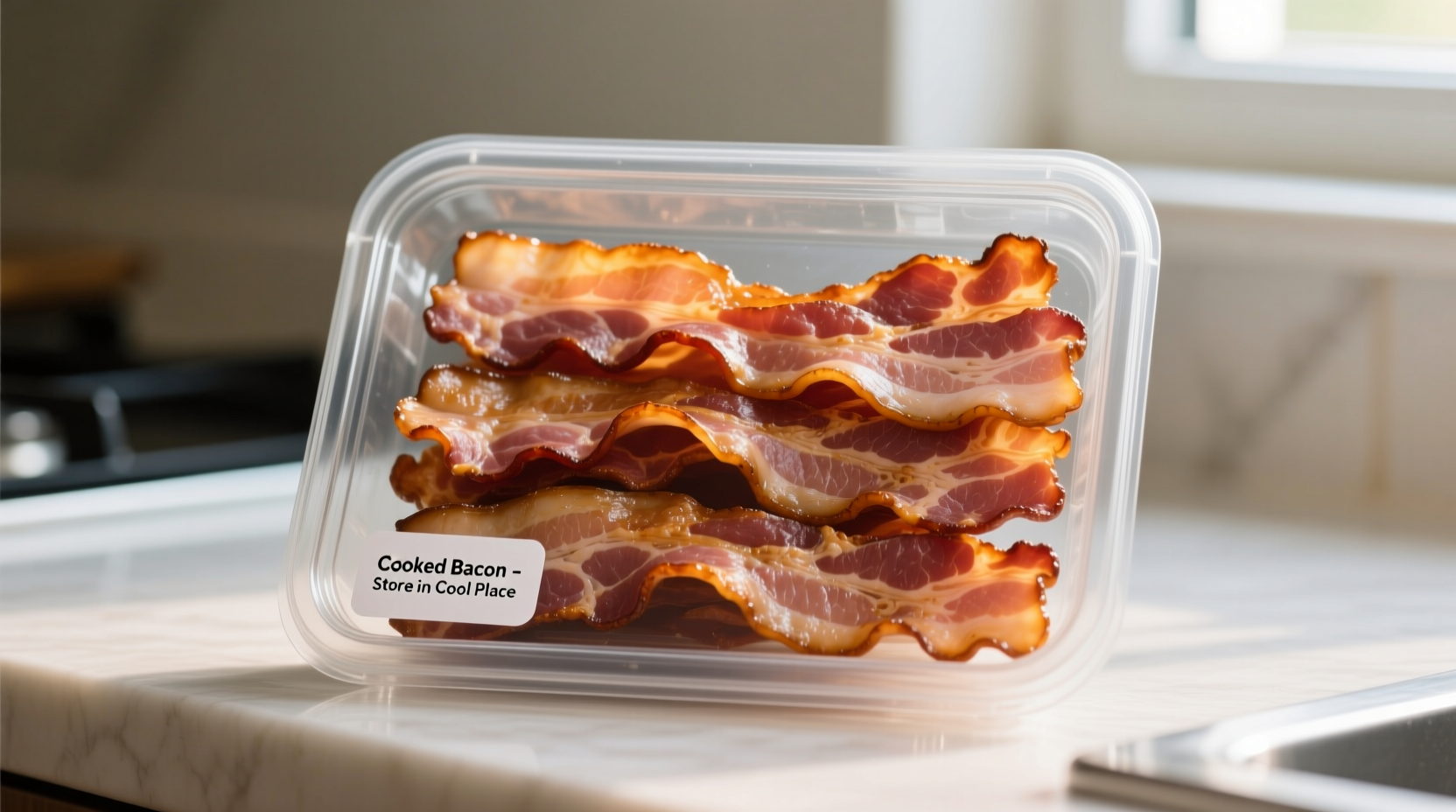Cooked bacon stays fresh and safe in the refrigerator for 4-5 days when stored properly in an airtight container at or below 40°F (4°C). This timeframe applies to standard cooking methods and typical home refrigerator conditions.
Discover exactly how to maximize your cooked bacon's shelf life while avoiding foodborne illness risks. This guide delivers science-backed storage methods from food safety experts, clear spoilage indicators to watch for, and practical tips that professional kitchens use to maintain bacon quality. Whether you're meal prepping for the week or saving leftovers from Sunday brunch, you'll learn precisely how to keep your bacon both delicious and safe.
Why Proper Cooked Bacon Storage Matters for Your Health
Improperly stored cooked bacon creates ideal conditions for dangerous bacteria like Staphylococcus aureus and Listeria monocytogenes to multiply rapidly. The USDA Food Safety and Inspection Service confirms that cooked meats left in the "danger zone" (40°F-140°F) for more than 2 hours can become unsafe to eat, potentially causing food poisoning with symptoms like nausea, vomiting, and diarrhea.
Bacon's high fat content actually helps preserve it slightly longer than leaner cooked meats, but its salt content isn't sufficient for long-term preservation without proper refrigeration. Understanding the exact storage window prevents unnecessary food waste while keeping your family safe.
Step-by-Step Guide to Maximizing Cooked Bacon Shelf Life
Follow these professional-tested methods to ensure your cooked bacon maintains both safety and quality throughout its storage period:
- Cool rapidly: Transfer cooked bacon to a wire rack immediately after cooking to prevent steam from creating moisture that accelerates spoilage
- Store within 2 hours: Refrigerate bacon before bacteria reach dangerous levels (1 hour if kitchen temperature exceeds 90°F/32°C)
- Use proper containers: Choose airtight glass or BPA-free plastic containers rather than original packaging
- Layer with paper towels: Place parchment paper or paper towels between bacon strips to absorb excess grease
- Set correct temperature: Verify your refrigerator maintains 40°F (4°C) or below using an independent thermometer
| Storage Method | Refrigerator Shelf Life | Freezer Shelf Life | Quality Notes |
|---|---|---|---|
| Original packaging (unopened) | 2-3 days | 1 month | Rapid quality degradation due to air exposure |
| Airtight container with paper towels | 4-5 days | 1-2 months | Best refrigerator method for maintaining crispness |
| Vacuum-sealed | 5-6 days | 3-4 months | Optimal for long-term storage with minimal quality loss |
| Plastic wrap (direct contact) | 3-4 days | 1 month | Prevents drying but may transfer plastic taste |
How to Recognize Spoiled Cooked Bacon: The 4-Point Safety Check
Don't rely solely on expiration dates—your senses provide the most reliable indicators of spoilage. Conduct this quick safety assessment before consuming refrigerated cooked bacon:
- Visual inspection: Look for slimy film, unusual discoloration (green, gray, or white spots), or visible mold growth
- Smell test: Fresh cooked bacon has a pleasant smoky aroma; spoiled bacon develops a sour, fishy, or ammonia-like odor
- Texture check: Properly stored bacon remains slightly crisp; spoiled bacon feels slimy or sticky to the touch
- Taste warning: Never taste bacon that shows any other spoilage signs—pathogenic bacteria don't always alter taste
According to the FDA Food Code, when in doubt about cooked bacon's safety, follow the "when questionable, throw it out" principle. Consuming spoiled bacon risks serious foodborne illness that outweighs the cost of replacement.

Special Considerations That Affect Cooked Bacon Shelf Life
Certain factors can shorten or extend the standard 4-5 day refrigerator window. Be aware of these context boundaries that impact storage duration:
- Cooking method matters: Oven-baked bacon typically lasts longer than pan-fried due to more consistent cooking and less residual grease
- Sugar content: Candied or maple-glazed bacon has reduced shelf life (3-4 days) due to sugar attracting moisture
- Refrigerator conditions: Frequent door opening or overstocking can create temperature fluctuations that shorten shelf life
- Initial cooking temperature: Bacon cooked to 165°F (74°C) lasts slightly longer than medium-cooked bacon due to more thorough pathogen reduction
The USDA Food Safety and Inspection Service notes that these variables typically affect quality more than safety within the standard timeframe, but extreme conditions can compromise safety even within 4 days. Always prioritize visual and olfactory inspection over calendar dates.
Extending Your Cooked Bacon's Usability Beyond 5 Days
For longer storage, freezing remains your safest option. Follow these professional techniques for optimal results:
- Flash-freeze individual strips on a parchment-lined baking sheet before transferring to storage containers
- Portion bacon into meal-sized quantities to avoid repeated thawing and refreezing
- Remove as much air as possible from freezer bags using the water displacement method
- Label containers with both freeze date and "use by" date (1-2 months later)
- Thaw frozen cooked bacon overnight in the refrigerator, not at room temperature
When reheating refrigerated cooked bacon, use the oven or air fryer rather than the microwave for best texture retention. The FoodSafety.gov database confirms that proper reheating to 165°F (74°C) kills any surface bacteria that may have developed during storage.
Common Questions About Cooked Bacon Storage
These frequently asked questions address the most pressing concerns home cooks have about keeping cooked bacon safe and delicious:











 浙公网安备
33010002000092号
浙公网安备
33010002000092号 浙B2-20120091-4
浙B2-20120091-4